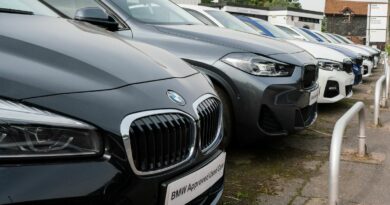GM's Battery Plants Will Be Covered By UAW Agreement In "Major Breakthrough"
Now in its 21st day, the United Auto Workers’ strike on General Motors, Ford, and Stellantis has proven to be a bitter, protracted affair. But electric vehicles have been looming large over all of it — namely, the fact that most EV battery plants in the US are not unionized, and future EVs may require far less in the way of parts, labor and jobs than conventional cars currently do.
But on Friday afternoon, UAW President Shawn Fain announced what he called a “major breakthrough” with GM specifically: its battery manufacturing will be placed under the UAW’s Master Agreement, meaning future battery jobs will be union ones.
“Moments before this broadcast, we have had a major breakthrough that has not only dramatically changed negotiations, but it’s going to change the future of our union and the future of our industry,” Fain said on his weekly livestream broadcast while wearing an “Eat The Rich” t-shirt.
“We were about to shut down GM’s largest moneymaker in Arlington, Texas,” he said, referring to the UAW’s practice of expanding its strikes each Friday as negotiations stalled. “Just that threat has provided a transformative win.”
We sent an email to GM seeking comment; we’ll update if we get it.
The agreement is indeed a significant one. To date, most battery plants serving Ford, GM, and Stellantis are not unionized — often because they’re joint ventures with other companies like SK On or LG. But that has meant those workers were paid significantly lower hourly wages than their unionized counterparts. And while battery plant unionization was not an initial part of the UAW’s demands, the idea that the battery-driven future of the American auto industry would mean lower wages than what workers currently make became a significant sticking point for members. (Last year, independently of this, one GM battery plant in Ohio also voted to unionize with the UAW.)
“What this will mean for our membership cannot be understated,” Fain said, saying GM intended to replace engine and transmission manufacturing jobs with “low-wage battery jobs.”
GM’s decision also averted a strike on Texas’ Arlington Assembly Plant, makers of the lucrative Chevrolet Tahoe and Suburban, GMC Yukon, and Cadillac Escalade. Likely, that outcome was the last thing GM wanted, as a work stoppage at that plant would’ve significantly cut into its profits.
It’s also unlikely the UAW plans to stop asking for battery plants to be covered under its agreements, now that it’s scored a win with GM; this move alone seems poised to significantly increase the membership of a union whose ranks have been thinning for decades. Fain seemed to indicate as much: “We expect [our plan] to win at Ford and Stellantis as well,” he said.
The entire UAW strike has been a kind of clash of past and future. Workers say they gave up too much in the way of pay and benefits to keep their automakers alive during the Great Recession. They also say that their current wages — while higher than the Asian and European automakers in America, and Tesla — have not kept up with inflation, all while the automakers post record profits and their CEOs earn more than $20 million per year in total compensation.
The current leadership of the UAW is also considerably more militant than in past decades. After years mired in a corruption scandal that sent some of its leaders to prison, Fain was narrowly elected in March and has since led a much more aggressive campaign than his predecessors — who were known for undertaking things like a genial “handshake ceremony” before negotiations began. This UAW, however, has made the unprecedented move of striking on all three automakers at once and escalating strikes almost weekly.
The automakers, however, have said the UAW’s pay raise demands could, as Ford CEO Jim Farley put it recently, “have a devastating impact on our business.” They have also argued that those record profits will be necessary to front the billions of dollars needed to transition to a more electric vehicle-focused market in the coming years. But with that came the UAW’s concerns about whether an EV future will include union labor or not.
All told, this is a stunning development in one of the auto industry’s most significant labor actions to date — and one that has now directly roped in the EV world as well.
Source: Read Full Article



